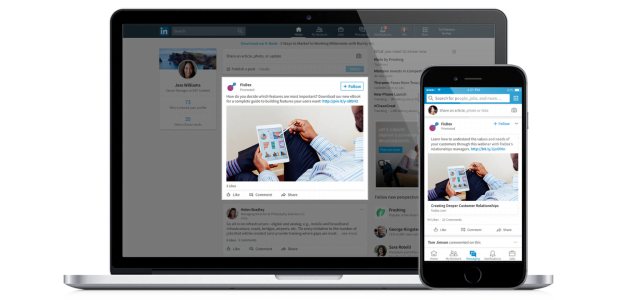LinkedIn ads can help your business reach a powerful professional audience. Not only are LinkedIn members influential, they also have two times the buying power of the average web crowd.
A recent revamp of LinkedIn’s advertising platform, Campaign Manager, has added a few new tools to the LinkedIn marketer toolbox. In addition to sharper targeting options, the platform made the switch to objective-based advertising. That means advertisers can now run campaigns around clearly defined goals, such as brand awareness, lead generation, or engagement.
This guide will cover the different ad formats available, a step-by-step guide on how to advertise on LinkedIn, and a rundown of best practices—with exclusive insights provided by LinkedIn to Hootsuite that you won’t find anywhere else.
Types of LinkedIn ads
Learn how to advertise on LinkedIn with the platform’s different self-serve ad formats.
Sponsored Content
Sponsored ads are essentially promoted LinkedIn posts.
There are three different formats available for Sponsored Content ads: single image, video, and carousel.
Campaigns can run as native news feed ads and Lead Gen forms.
This is a good ad type if your goals include engagement, especially since feed engagement has grown 50% from 2017 to 2018.
Pro tip: Hootsuite users can promote Sponsored Content from within the Hootsuite dashboard. The Hootsuite Academy video below provides step-by-step instructions on how to do it.
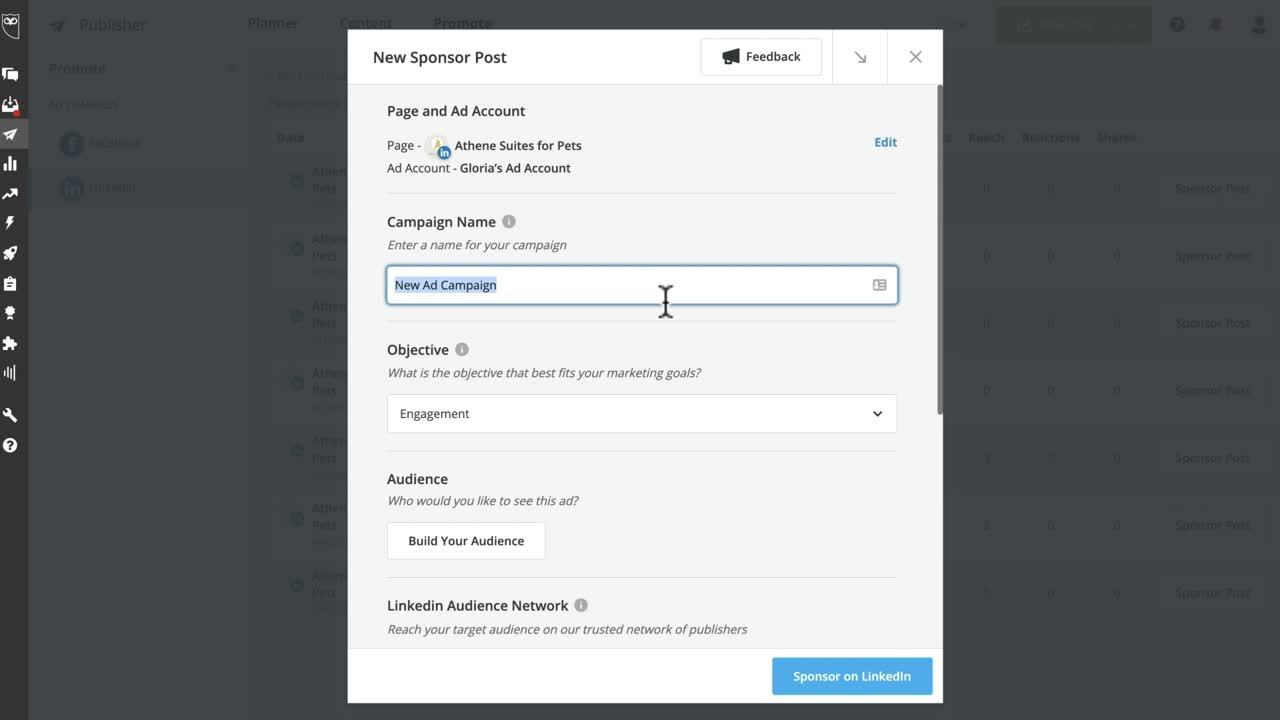
Direct Sponsored Content
The difference between Direct Sponsored Content and Sponsored Content is that these ads are not published on your LinkedIn page feed. But they still look like a regular LinkedIn post.
Why is this an advantage? For starters, you can tailor the ad to target a specific audience. Also, you can test different iterations without mucking up your page.
Sponsored InMail
This ad format delivers targeted messages to LinkedIn-member inboxes. According to LinkedIn, these ads are more successful at driving conversions than emails.
Keep in mind that LinkedIn members can opt out of receiving InMail ads.
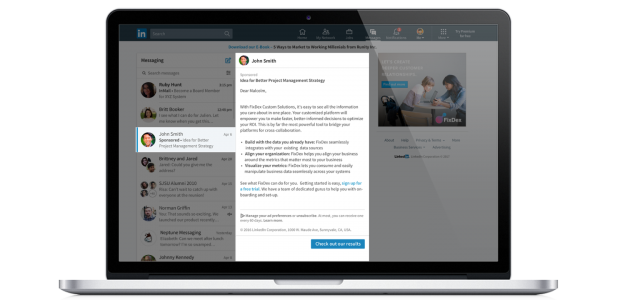
Text Ads
LinkedIn text ads appear in the right rail and top banner on desktop. They include a short headline, blurb, and a small square image.
These ads are measured by pay-per-click or cost-per-impression.
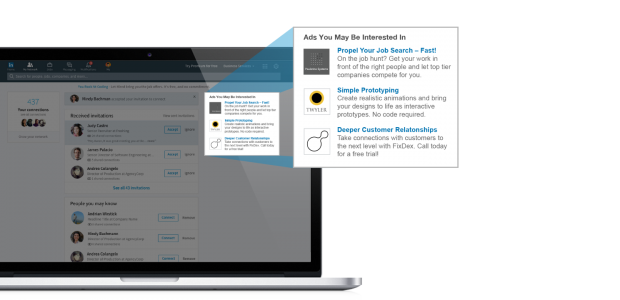
Dynamic Ads
LinkedIn Dynamic Ads also appear in the right rail and look similar except for an important difference. Each ad can uniquely target its viewer with their profile photo and address them by name.
Dynamic ad formats include follower, job, content, and company spotlight ads.
To create a Dynamic content ad, you’ll need to get in touch with a LinkedIn representative.
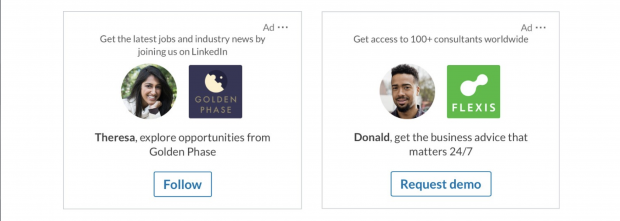
LinkedIn Audience Network
LinkedIn Audience Network is a feature that allows advertisers to target their desired audience with sponsored content on thousands of partner apps and websites. You can enable this feature when creating your campaign so that your ad is seen in more places outside of LinkedIn, too.
LinkedIn Advertising Partner Solutions
If running self-serve ad campaigns isn’t cutting it, consider trying the LinkedIn Marketing Partner program.
The program partners businesses with a slate of handpicked companies that have the expertise to help you meet your marketing goals. Whether you need help targeting audiences more effectively, boosting engagement, or scaling your campaigns. There are more than 60 partner companies available, including Hootsuite.
LinkedIn Display ads are no longer offered on the platform.
How to advertise on LinkedIn: a step-by-step guide
Follow these steps to start your first LinkedIn advertising campaign.
Need help setting up a company page first? Our LinkedIn for Business guide covers all the bases.
1. Sign in to Campaign Manager or create an account.
From there, click Create Campaign.
Don’t forget to add a name. LinkedIn suggests including these details in the name:
- Business line/product
- Reference to the marketing campaign title
- Campaign type (i.e. Webinar, whitepaper etc.)
- Geo/region
- A unique campaign ID that matches with other channels
- A date range for the campaign timeframe
Here’s an example: “Product_CampaignName_CampaignType_ Geo_UniqueID”
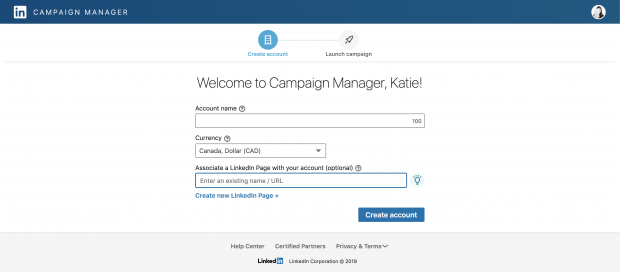
2. Choose your ad objective.
3. Set up your audience targeting parameters.
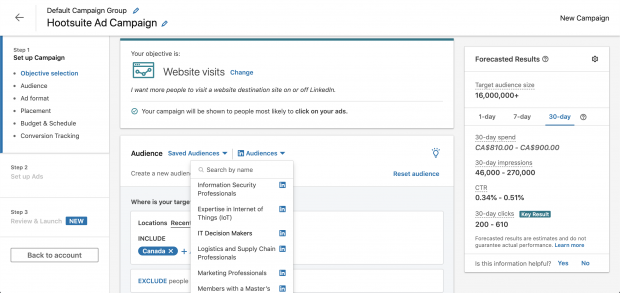
LinkedIn recommends starting with an audience size of over 50,000 members, especially for a new campaign. For Sponsored InMail, aim for more than 15,000 members.
- Pick recent or permanent location.
- Add locations you would like to include, or exclude those you do no with to include.
- Select the profile language of your target audience.
- Add audience attributes. These include company, demographics, education, job experience, and interests.
- Use “or” to broaden your audience. For example, your audience could include “photographers” or “graphic designers.”
- Use “and” to narrow your audience. In this case, you may wish to target someone who’s a photographer and graphic designer.
- Enable Audience Expansion to show ads to LinkedIn audiences with similar attributes.
Alternately, you can add a Matched Audience, consisting of a customer list of newsletter subscribers, website visitors, etc. Simply select Matched Audience and add a link to your company website to retarget website visitors, or upload a list to create an audience.
Make sure to hit Save as a template before moving to the next step. That way, if you need to target the same audience again, you’ll be able to retrieve your settings under Saved Audiences.
4. Select the ad format you would like to use. Most formats require you to enter your Company or Showcase Page before proceeding.
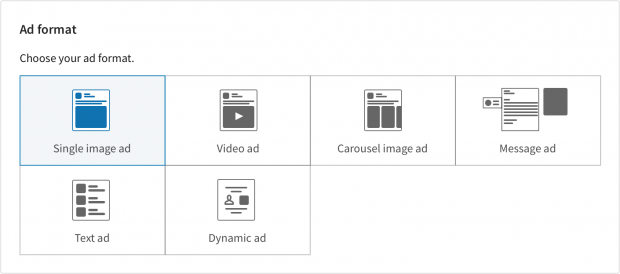
5. If available, consider enabling the LinkedIn Audience Network.
6. Set your budget and campaign schedule.
You can choose to set a total budget, or both a daily budget and total budget.
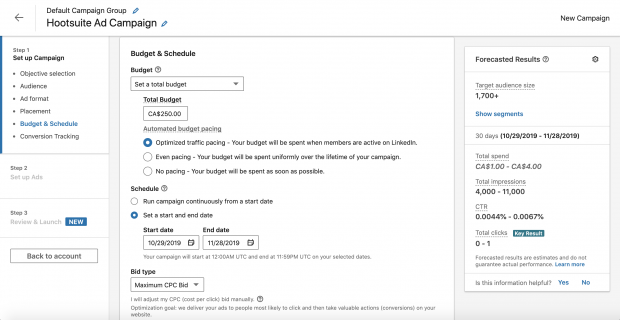
For bid type, choose between cost-per-clicks and cost-per-impressions depending on your goals. If you’re creating a Sponsored InMail campaign, you will choose cost-per-send.
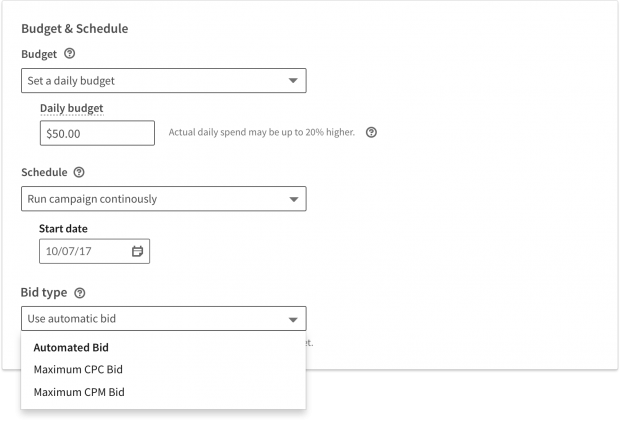
LinkedIn reports seeing a 33% higher return on investment when advertisers have placed bids within the suggested range.
7. Optional: Create a conversion. This allows you to track actions people take on your website after viewing your LinkedIn ad.
You can either install a site-wide Insight Tag, which is what LinkedIn recommends, or use an event-specific pixel to track conversions.
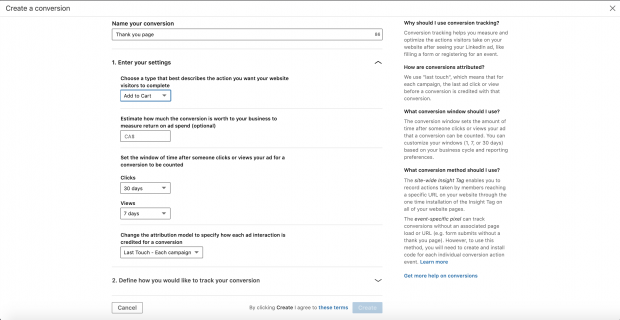
8. Set up your ad.
As you create your ad, you’ll be able to preview what it will look like. For Sponsored InMail, you can send yourself a test message.
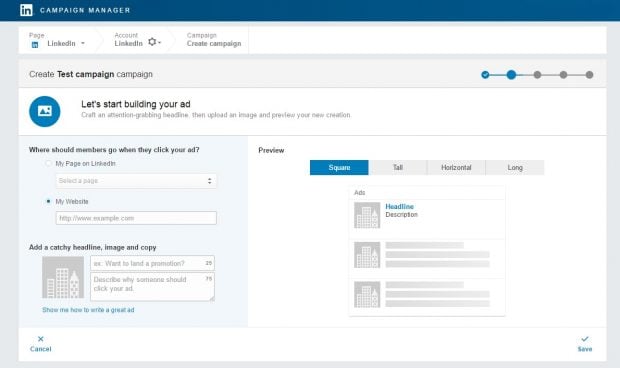
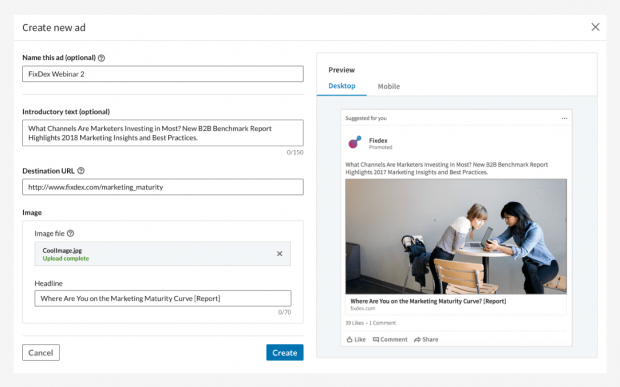
9. Review and launch your campaign.
Before they go live, LinkedIn will review your ads to ensure they meet the platform’s standards.
This usually takes around 24 hours, but can take longer. Check the status column in Campaign Manager to see if your ads have been approved.
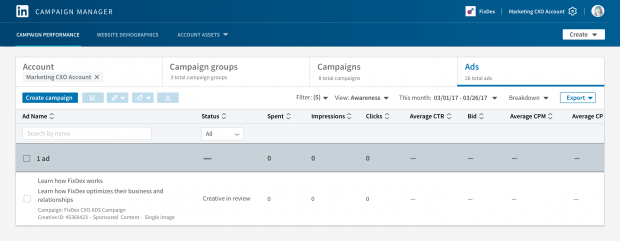
10. Optimize performance.
Once you’ve started your campaign, use Campaign Manager’s Performance Chart to track its metrics and make informed adjustments.
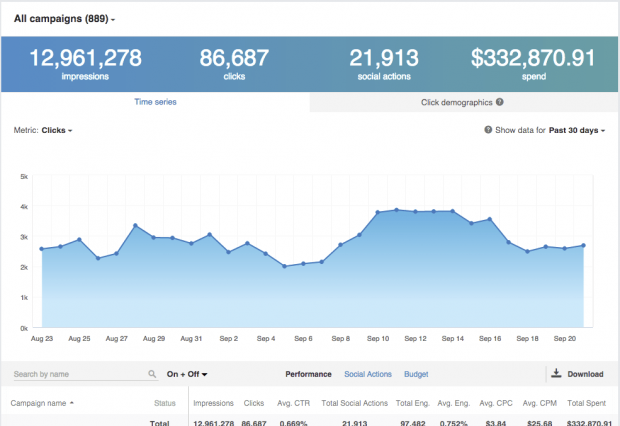
For more format-specific instructions, check out these LinkedIn advertising resources:
LinkedIn ads best practices
Take these LinkedIn ads best practices into consideration before you create your next campaign.
Target the right LinkedIn audience
A LinkedIn ad campaign will only be as good as the audience it targets. Cast too wide of a net, and you may not hit your performance and budget goals. Too small of a net you lower the chances of connecting with valuable LinkedIn members.
LinkedIn’s targeting capabilities allow you to target audiences based on location, company, company industry, age, gender, education, job experience, job title, interests, groups, and more.
A good place to start is by familiarizing yourself with LinkedIn member demographics, and looking for overlap with your customer profiles. Then consider the location and language of the members you’d like to reach. Consider also breaking out your campaigns by region so that you target each time zone evenly.
Be strategic with your next choices. For example, LinkedIn finds that use job function versus job title can result in more reach and a higher click-through-rate (CTR).
Here are some targeting suggestions from LinkedIn:
- Target by Geography/Industry/Seniority (e.g., UK/High-Tech/Manager)
- Target by Geography/Specific Skills (e.g., France/PPC, SEM)
- Target by Geography/Type of LinkedIn Group (e.g., AUS/Recruiting, HR)
Matched Audience lists and Website Retargeting are tools that can help you exclude or include current customers are already engaged members. Audience Expansion can help you reach a larger audience, which is particularly useful for awareness campaigns.
Remember not to overdo it. The more audience parameters you add, the smaller your audience will be.
And don’t forget to retarget ads. Research shows that retargeted ads—ads that are shown to the same member more than once—are 70% more likely to convert and have a 10 times higher CTR on average.
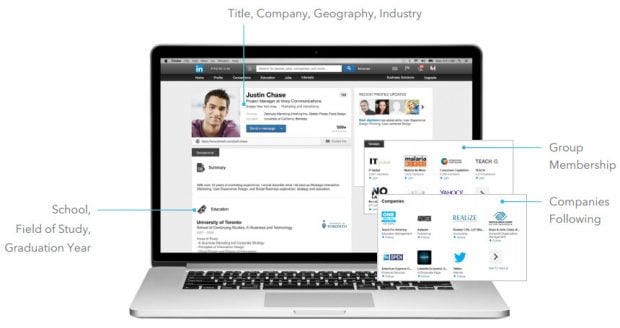
Keep content short
Use LinkedIn Ad copy to capture attention and convey essential information. Attention spans are short on social media. If your blurb is too long, your audience might scroll right past it.
Here are the suggested character and time limits for each LinkedIn ad format:
Sponsored Content
- Headlines should be under 150 characters.
- Descriptive copy should be under 70 characters. Text higher than 100 characters will be truncated on desktop.
- According to LinkedIn, posts with fewer characters had an 18% higher engagement rate on average.
Sponsored Video
- Videos for brand awareness and consideration goals should be less than 30 seconds long. LinkedIn finds that videos this length have a 200% higher completion rate than videos that run longer.
- Video used for marketing later in the funnel should be around 90 seconds long. Bottom funnel can be anywhere from two to six minutes. That means if you’re targeting people who are already engaged with your brand, they’ll likely be more receptive to longer content.
Sponsored InMail
- Messages should be under 1,000 characters, including a link.
- LinkedIn finds that body copy that has less than 500 characters have a 46% higher CTR on average.
- Fun fact: Members click on Sponsored InMails the most over the weekend. But they open Sponsored InMails the most on Tuesdays.
Dynamic Ads
- Keep copy short and concise. If you don’t need it, don’t use the secondary headline.
- In tests, LinkedIn finds that ads with only a primary headline have a 25% higher CTR on average.
Be upfront with your message
Don’t beat around the bush. Cut straight to the chase with your LinkedIn ad’s message.
Share the value you’d like to offer members upfront, whether it’s information that will help them excel in their professional careers, market insights, or business networking opportunities.
For videos, you have two to three seconds to capture attention. Make sure you share your most crucial information in the first 10 seconds, before distractions get in the way.
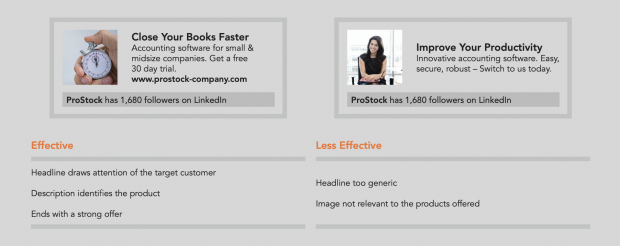
Call out noteworthy stats and quotes
A good way to capture attention is with a standout statistic or quote. Bite-sized tidbits are often easier for people to digest in the crowded social media space.
Highlight a punchy fact or pull quote to lure people in, and then follow through with an irresistible offer.
LinkedIn tested an update with a statistic and without one to measure the performance differences. The results are telling. The update with a statistic had a 37%t higher CTR and 162% more impressions.
Don’t count quotes out. Overall, LinkedIn finds that quotes outperform stats with a 30% higher CTR.
Why? A lot of the content that performs best on LinkedIn tends to put people first. Pick a short quote that people can connect with, and consider including an image of the person being quoted.
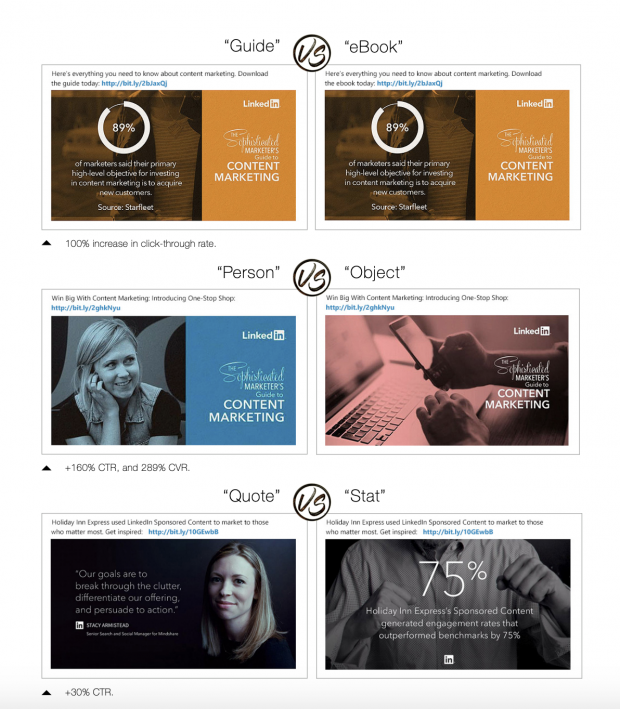
Choose clear call-to-actions
Call-to-actions can be easy to ignore when they’re muddled or too complicated. Choose an action that’s compatible with your advertising objective, and stick with simple and direct language.
The top Sponsored InMail keywords are:
- Try
- Register
- Reserve
- Join
- Confirm
- Download
If you’re not seeing as many actions as you’d like, try testing another keyword. In internal tests, LinkedIn finds that Register outperformed Join by 165% more clicks.
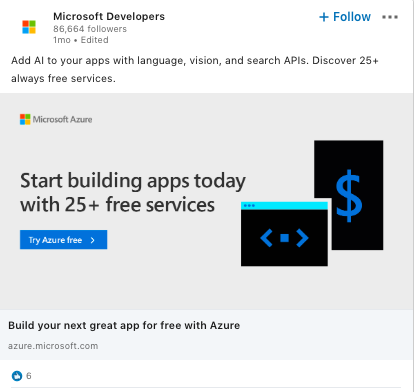
Personalize as much as possible
It may seem difficult, at first, to personalize an ad for a large audience. But with proper targeting and these pointers, you can tailor your ads to better connect with the people you’re trying to reach.
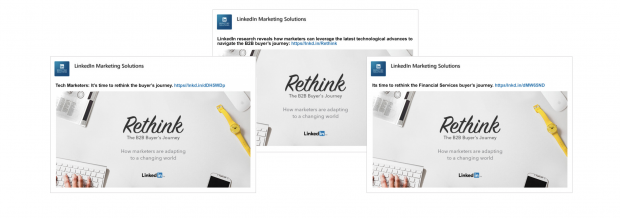
Text Ads
- Address your audience directly.
- Examples include: “Are you a teacher?” or “Attention all teachers:”
Sponsored Content
- Call out your target audience with direct language.
- LinkedIn ads that directly address the target audience have a 19% higher CTR and 53% higher conversion rate than those that don’t.
Sponsored InMail
- Add a personal greeting. You can do so by adding: %FIRSTNAME%, %LASTNAME%.
- Mention the recipient’s job title.
- Use “you” somewhere in the message.
Dynamics Ads
- Enable the profile image. Doing this will put the profile picture of the viewer right in your ad.
- On average, LinkedIn finds that Dynamic Ads with the profile image enabled have a 100% higher CTR and 100% higher conversion rate than those without the photo enabled.
Include people-centric visuals
At its core, LinkedIn is a platform that members join to make connections with other people. So it’s unsurprising that content featuring people tends to perform well.
According to LinkedIn, ads with people in them can increase your CTR by as high as 160%.
Remember to avoid images that are too small or low in quality. For Sponsored Content, 1200 x 627 pixels is the recommended size.
LinkedIn also says that content with larger visuals have a 38% higher average CTR.
Also, make sure the image is legible on small devices, since more than 85% of LinkedIn engagement is on mobile. That means your subject or subjects shouldn’t be too far from the lense or drowned out by a busy scene. Shoot or look for pictures that put people first.
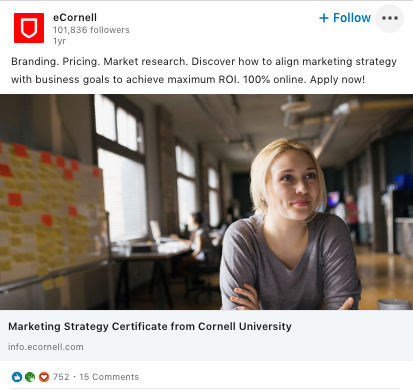
Test variations for each campaign
You can follow every LinkedIn ad best practice tip in the book, but ultimately, every campaign takes a little tweaking and testing to get right.
Try to run two or three variations on your campaign. This allows you to test which one performs best, and at the same time, offers some variety to your audience.
There are a few ways you can A/B test you LinkedIn ads. Change the copy or the call-to-action to see what language your audience responds to most. Or, switch up visuals to measure which ones make a stronger mark.
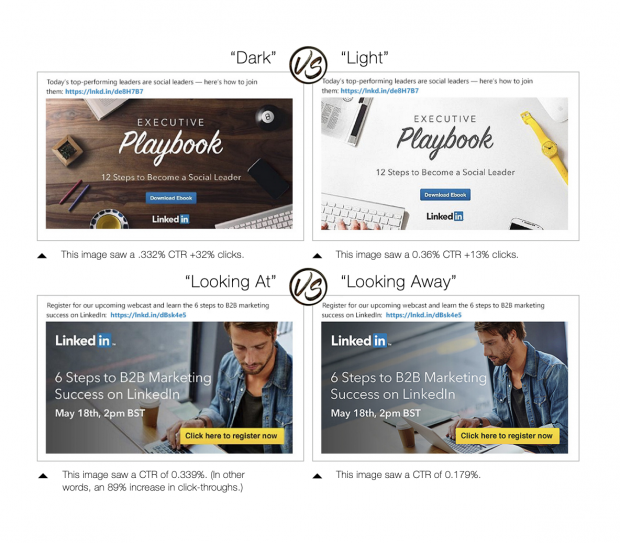
LinkedIn recommends that you pause the ad with the lowest engagement and replace it with new creative. Doing this will improve your ad relevance score and allow you to win more bids in the process.
Keep track of your findings for future campaigns, especially if you plan to target the same or similar audiences.
Easily manage your LinkedIn Page alongside your other social channels using Hootsuite. From a single dashboard you can schedule and share content, engage your network, and promote Sponsored Content posts. Try it today.
Get Started
